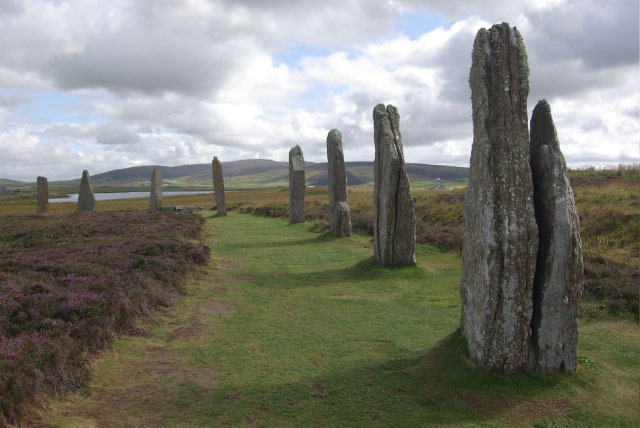
28 Sep Unveiling the Ring of Brodgar: A Journey to Scotland’s Ancient Past
Unveiling the Ring of Brodgar: A Journey to Scotland’s Ancient Past
Discover Orkney’s Mystical Stone Circle
Set within the rugged landscape of Orkney, the Ring of Brodgar is one of Scotland’s most intriguing and iconic ancient monuments. With its towering stones standing in a perfect circle, the Ring of Brodgar draws visitors from around the world, beckoning them to explore its ancient mysteries. Dating back to the 3rd millennium BC, this Neolithic stone circle has remained a silent witness to countless generations, weathering the elements and holding secrets of a distant past. Curious to step back in time? Let’s explore the history, mystery, and allure of the Ring of Brodgar.
What is the Ring of Brodgar?
An Ancient Ceremonial Monument
The Ring of Brodgar is a large ceremonial stone circle and henge located in the Heart of Neolithic Orkney World Heritage Site. Built over 4000 years ago, this site consists of 36 standing stones, though it is believed there were originally 60. These stones form a perfect circle, measuring about 104 meters in diameter, making it one of the largest stone circles in the British Isles[5].
The Purpose of the Ring
Rituals, Ceremonies, and Community Gatherings
Like many Neolithic monuments, the exact purpose of the Ring of Brodgar remains a mystery. It is widely believed to have been a sacred site used for religious rituals, ceremonies, and possibly astronomical observations. The monument’s proximity to other ancient sites such as Maeshowe and the Standing Stones of Stenness suggests it was part of a larger ceremonial landscape. Was it a place of worship, a calendar for tracking the seasons, or something else entirely? We can only guess, but the aura of mystery surrounding the site adds to its allure.
Exploring the Ring of Brodgar
What You’ll Find When You Visit
Stepping into the Ring of Brodgar feels like crossing a threshold into another world. The stones, weathered by time, tower above you, standing sentinel over the moorland. While only 36 stones remain, their sheer size and the precision of their placement are a testament to the skill and dedication of the people who built it.
Walking Among the Stones
An Immersive Experience in History
Walking around the ring, it’s hard not to wonder about the people who once gathered here. What were they thinking as they erected these stones? What stories did they tell? These thoughts swirl as you make your way through the circle, the surrounding landscape of heather and rolling hills enhancing the sense of timelessness.
The Stones Themselves
Silent Giants of the Past
The standing stones range from 2.1 to 4.7 meters in height, and while their origin is uncertain, it’s believed the stones were sourced locally. Their arrangement in a perfect circle suggests a deep understanding of geometry and spatial awareness, hinting at the advanced knowledge of the Neolithic people[6].
A Part of Neolithic Orkney
The Ring of Brodgar’s Place in History
The Ring of Brodgar is just one piece of a much larger puzzle. The monument forms part of the Heart of Neolithic Orkney, a UNESCO World Heritage Site that also includes Skara Brae, Maeshowe, and the Standing Stones of Stenness. Together, these sites offer a rare glimpse into Neolithic life, showcasing the ingenuity and culture of our ancestors.
The Role of Astronomy
Was the Ring of Brodgar an Ancient Calendar?
Many historians believe that the Ring of Brodgar, like other stone circles, may have been used to track the movements of the sun, moon, and stars. Its location, orientation, and possible alignments with celestial events suggest that the monument played a key role in ancient astronomical practices[1].
The Mysteries of Brodgar
Unanswered Questions and Theories
Despite years of study, much about the Ring of Brodgar remains shrouded in mystery. Why was it built? Who were the people that used it? And what exactly happened here? Some believe the site was used for ritual sacrifices, while others think it served as a communal meeting place for tribes from across Orkney. Whatever the purpose, the site continues to captivate archaeologists and visitors alike.
The Significance of the Lochs
Natural and Man-Made Harmony
The Ring of Brodgar is unique in its location, situated between two lochs — the Loch of Stenness and the Loch of Harray. This natural setting, combined with the man-made monument, creates a striking visual contrast. Some experts suggest the lochs were an integral part of the site’s ceremonial use, representing the boundary between the physical and spiritual worlds[5].
Visiting the Ring of Brodgar Today
Practical Information for Modern Explorers
If you’re planning to visit the Ring of Brodgar, here are a few tips to make the most of your experience.
Admission and Access
Open Year-Round and Free of Charge
The Ring of Brodgar is free to visit and open year-round. There are no restrictions on access, but be mindful of the weather, as Orkney’s climate can be unpredictable. Comfortable footwear and warm clothing are a must, especially if you plan to spend time exploring the surrounding area.
Guided Tours
Visit with a Local Guide
While you can visit the Ring of Brodgar on your own, joining a guided tour can provide a deeper understanding of the site’s history and significance. Local guides offer fascinating insights into the stone circle, the Neolithic landscape, and the theories surrounding its purpose.
The Timeless Appeal of the Ring of Brodgar
Why It Continues to Fascinate
The Ring of Brodgar has captivated people for thousands of years, and it continues to do so today. Whether you’re drawn to its architectural brilliance, its spiritual significance, or its sheer mystery, the stone circle offers a connection to our ancient ancestors. Visiting this site is more than just a history lesson — it’s a reminder of the enduring human quest to understand the world around us.
